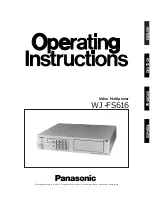
Appendix F Command Set Description
MX-2100/2104
Installation and Operation Manual
F-36
Commands
•
CONTROL SIGNALS
- Displays the control signal support mode for the
corresponding channels. The following codes can appear:
LOCAL
- Channel configured for local control signal support (data
channel only).
RTS
- Channel configured for end-to-end transmission of RTS line state
(data channel only).
DTR&RTS
- Channel configured for end-to-end transmission of DTR
and RTS lines states (data channel only).
SIGNALING
- Channel configured for end-to-end transmission of E and
M signaling (voice channel only).
N/A
- Not applicable: displayed in lines with COMP i:*.
DSP FLIP
Purpose
Display the cause of the last switching (flip) from one main link to the other.
This command is accepted only when MX-2100 operates in the switched backup,
priority bumping, or redundancy mode.
Format
DSP FLIP
Use
•
Type:
DSP FLIP <ENTER>
The following message is displayed:
LAST FLIP CAUSED BY: 'cause'
The following 'cause' descriptions can be displayed:
NO FLIP
- No flip occurred.
FORCED FLIP
- Flipping occurred as a result of operator's command
(
FLIP ML
).
ML CTS OR DSR IS OFF
- Flipping occurred because the CTS or DSR
line in the interface of the KML module serving the previously used link
had been switched off by the modem. This cause can appear only
when the DSR&CTS main link parameter is set to EXT.
ML HARDWARE FAILURE
- Flipping occurred after a hardware failure
has been detected in the KML module serving the previously used link.
ML LOCAL SYNC LOSS
- Flipping occurred because the local KML
module serving the previously used link lost frame synchronization.
ML REMOTE SYNC LOSS
- Flipping occurred because the remote KML
module serving the previously used link lost frame synchronization.
ON LINE ML REMOVED
- Flipping occurred because the KML module
that was previously on-line has been removed from its slot.
















































